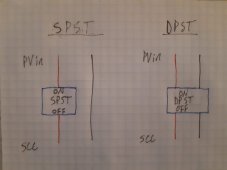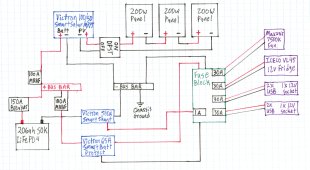Why is current flow on the battery bi directional if they are separated as + and - poles? Everywhere else is uni directional? Is this because the shunt and the breaker function of both incoming and outgoing current?
The battery can be charged or discharged.
When its being charged the current goes backwards through the battery.
On this same note, this means a current over 150A will trip that breaker.
Yes.
Over-current devices have a trip curve.
One axis is current the other axis is time.
The SOK 206ah has a max continuous discharge current of 100A and a peak discharge current of 200A for 3 sec. If somehow I used something that draws over 150A from the battery it will trip that breaker right?
Yes but not right away.
Without actually looking at the trip curve I would guess 150% of rating for 60 seconds would trip the breaker.
A dead short will trip it in milli-seconds.
Is this an unfounded concern because it's unlikely I would ever draw over 150A with a device or is it smart to size the breaker to 200A.
If you want a 200 amp breaker then you need 2 awg wire.
Also on the shunt, I was under the impression the smartsolar mppt would provide me all of the information about the battery I needed.
Nope not even in the same ballpark as a shunt.
What other info is the smartshunt going to provide that you find pertinent?
State of charge.
The solar charge controller can't do that.
You are recommending the MRBF fuse for these 100A fuses right? Why are they sized for 100A?
Because the wire is 6 awg.
We size the fuse to the wire.
Actually for the battery protect circuit make that an 80 amp fuse.
Why is this only 1A fuse?
Because the current draw of the shunt will be 1 or 2 milli-amps and that is the smallest fuse that we can fit in the fuse_block
How are you determining 30A fuses here?
Because the wire is 10 awg and we fuse for the wire.
You're recommending ferrules on the pv input side right?
Yes.
Is this just to make a nice clean connection into the mppt?
Fine stranded wire without ferrules has a nasty habit of shorting to the neighbor terminal.
It also has a nasty habit of squirming in the terminals cause the terminal to become loose.
Loose connections can cause fires.
Are they necessary or just aesthetically pleasing to you?
Not strictly necessary but I strongly encourage them.
Did you explore my links to the mrbf stuff at waytek?




